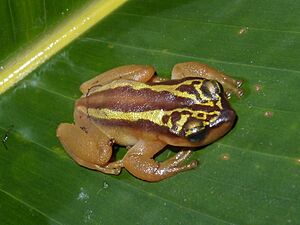Golden tree frog facts for kids
Quick facts for kids Golden tree frog |
|
|---|---|
 |
|
| Conservation status | |
| Scientific classification | |
| Synonyms | |
|
Amphodus auratus Boulenger, 1917 |
The Phytotriades auratus, also known as the golden tree frog, is a special kind of tree frog. It belongs to a group of frogs called Phytotriades. This group currently has only one known species: the golden tree frog itself! People also call it the bromeliad-dwelling treefrog or the Trinidad heart-tongued frog.
Contents
Discovering the Golden Tree Frog
For a long time, scientists thought the golden tree frog was part of another group of frogs called Phyllodytes. But after looking closely at its DNA, they realized it was very different. This frog lives far away from other Phyllodytes frogs, which are mostly found in Brazil. This genetic evidence helped scientists understand that the golden tree frog needed its own unique group.
Where Golden Tree Frogs Live
The golden tree frog lives in a few specific places. You can find it on the tops of El Cerro del Aripo and El Tucuche. These are the two highest mountains in Trinidad. It also lives on Cerro Humo in Venezuela, which is on the mainland nearby. There are also some clues that it might live on Isla Margarita too.
What Golden Tree Frogs Look Like
Male golden tree frogs grow to about 29 millimeters (just over an inch) long. Female frogs are a bit bigger, reaching about 35 millimeters. This measurement is from their nose to their bottom.
These frogs have some cool features! They have teeth that look like tiny saws. They also have sharp "fangs" on their lower jaw. These fangs are even bigger in male frogs. Their backs are a chocolate brown color. They also have two shiny, golden-yellow stripes that run along their backs.
Life and Habits of the Golden Tree Frog
Male golden tree frogs are very protective of their space. They will even use their fangs to fight other males! Interestingly, male golden tree frogs do not make calls or croaks. This is one way they are different from the Phyllodytes frogs.
These frogs likely don't have many babies at once. Scientists have found only about 5 or 6 tadpoles in a single bromeliad plant. When tadpoles first hatch, they are about 14 millimeters long. They can grow up to 40 millimeters long before they turn into frogs.
Home and Protection
In Trinidad, the golden tree frog lives in mountain rainforests. It also lives in "elfin woodlands," which are forests with small, twisted trees. These places are usually found around 940 meters (about 3,080 feet) above sea level. On Cerro Humo, they live in similar elfin forests near the mountain's peak, around 1,250 meters (about 4,100 feet) high.
The golden tree frog has a very special home: giant bromeliad plants called Glomeropitcairnia erectiflora. These plants collect water in their leaves, forming little pools. The frog's tadpoles grow and develop right inside these bromeliad pools!
Threats and Conservation
Sadly, the golden tree frog is facing some dangers. In Trinidad, people sometimes collect the bromeliad plants where the frogs live. They also collect the frogs themselves.
Some areas are protected to help these frogs. The Northern Range Game Sanctuary in Trinidad helps protect one group of these frogs. In Venezuela, part of their home is in the Península de Paria National Park. However, it's hard to enforce the rules there.
Another big threat is land clearing for farming. People sometimes clear land by burning trees, which destroys the frog's home. The golden tree frog needs cool, humid mountain forests to survive. With climate change and rising temperatures, these special forests might shrink. This could make the small areas where these frogs live even smaller, putting them in more danger.


